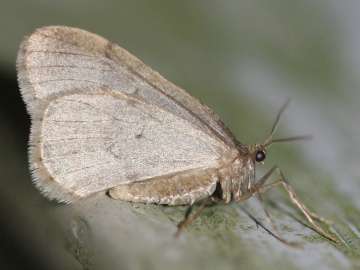

PHOTO COURTESY OF GARRY KESSLER
A moth in December in Westborough, possibly a winter moth, a European moth recently introduced in Massachusetts. At least two native moths, the bruce spanworm and the fall cankerworm, also fly at this time of year, from the first frost through January. The moths that fly now are males, searching for mates. The females can’t fly but instead wait on tree trunks and give off chemicals to attract males.
December 18, 2009, Page 4
NATURE NOTES
By Annie Reid
Westborough Community Land Trust
Moths in winter
We’re used to seeing moths at the porch light, but in December?
In late November and early December, before this month’s picturesque first snowfall, there the little tan moths were, flying beating their wings against outside lights or lighted windows.
What gives? Is this usual, or is it a symptom of global warming, or what?
Only in retrospect, many years from now, are we likely to know for sure whether our warm weather this fall was a symptom of global warming.
That issue aside, we’re probably seeing some combination of the usual and “or what.” Moths in winter in New England are more usual than unusual. Typically you can notice them flying in the woods from mid-November through January, sometimes even when temperatures are near freezing or slightly below.
Two native moths that are normally active in this period are the bruce spanworm (Operophtera bruceata) and the fall cankerworm (Alsophila pometaria). Since about 2000 they’ve been joined in Massachusetts by the winter moth (Operophtera brumata), a non-native moth from Europe, which we can put into the “or what” category.
All these moths are small and tan with subtle patterns on their wings. Most of us can’t tell them apart when we see them on the wing. The three kinds can occur together.
Surprisingly, the flying moths are all males. The females of these kinds of moths either have no wings or such tiny wings that they can’t fly.
What are they all up to? It’s not eating – these adult moths don’t eat. (They do their feeding in their caterpillar stage, in the spring, when they chow down on buds and leaves of many kinds of trees and shrubs.) It’s mating.
After the first frost, these moths emerge from the soil, where they’ve spent several months, as pupae, changing from caterpillars into adult moths. The females crawl up tree trunks and give off a scent chemical that attracts the opposite sex of their own kind – a pheromone. The males fly around searching for females and following their pheromones (and sometimes getting distracted by porch lights).
After they’ve mated and the females have laid eggs, typically on bark, the moths die. The eggs stay dormant throughout the winter. If you wonder what chickadees and nuthatches find to eat on our bare winter trees, these eggs may be one example.
Next spring, in late March or April, the eggs will hatch into tiny green inchworms, like so many others in our woods. While they’re still very tiny, these inchworms will spin themselves a strand of silk and hang from it until a breeze blows them higher into the treetops, where they’ll find the trees’ flower buds and leaf buds. There they’ll eat and grow until June, when they’ll go into the soil to transform into adults and eventually emerge as moths late next fall.
The caterpillars of all three moths have broad tastes. They’ll eat the flower and leaf buds of many kinds of trees, including oaks and maples, as well as various fruit trees and shrubs. Damage to blossoms of crabapple, apple, blueberry, and cherry affects the fruit that would result and can hurt crops.
Infestations of the native moth caterpillars – bruce spanworms and fall cankerworms – tend to run their course after three or four years, as diseases, parasites, and predators take their toll.
The winter moth is a concern in Massachusetts because it is non-native and doesn’t have the same natural controls (diseases, parasites, and predators) as in its native Europe. For a few decades it has been a pest in Oregon, Washington, and parts of western Canada, where it was first introduced in the 1950s. The winter moth has been spreading in eastern and southeastern Massachusetts, from Wellesley to Cape Cod, as well as in Rhode Island, eastern Connecticut, and coastal Maine. It seems to be coming our way, if it’s not here
Date index
Month (December)
Common name index
Scientific name index
Category index